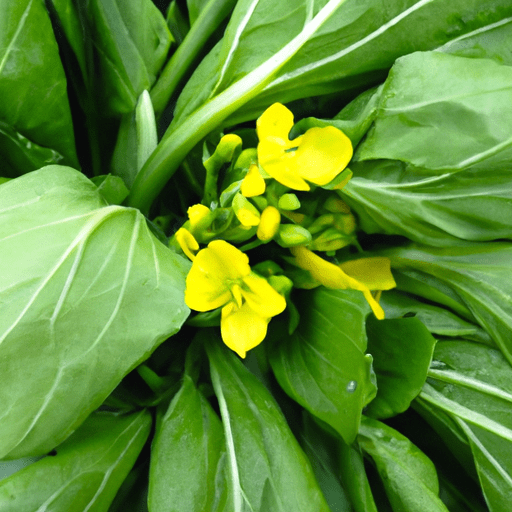Discover the Delights of Choi Sum: A Versatile and Nutritious Green Vegetable
If you are a fan of Asian cuisine or simply looking to add some variety to your vegetable repertoire, look no further than choi sum. This leafy green vegetable, also known as Chinese flowering cabbage, is a culinary gem that offers a delightful flavor and a range of health benefits. In this blog post, we will delve into the world of choi sum, exploring its taste profile, common uses in cooking, nutritional value, and some interesting facts about this versatile vegetable.
Taste Profile: A Delicate Balance of Bitterness and Sweetness
Choi sum offers a unique taste profile that combines mild bitterness with a delicate sweetness. The tender leaves and stems have a subtle, almost mustard-like flavor, while the yellow flowers add a touch of sweetness to each bite. This well-balanced taste makes choi sum a versatile ingredient that pairs well with a variety of other flavors, whether used in stir-fries, soups, or simply blanched and dressed with a light sauce.
Common Uses in Cooking: Embark on a Culinary Adventure
One of the great joys of choi sum is its versatility in the kitchen. Its tender leaves and stalks can be used in an array of culinary creations, adding color, texture, and flavor to your dishes. Here are some popular ways to enjoy choi sum:
Stir-fries: Choi sum shines in stir-fries, where its vibrant green color adds visual appeal. Simply toss it in a hot wok with garlic, ginger, and your choice of protein, along with some soy sauce or oyster sauce for a quick and satisfying meal.
Soup: Adding choi sum to a hearty soup provides a nutritious boost. Whether it’s a classic chicken soup or a comforting noodle broth, the tender leaves and stems of choi sum can be added towards the end of cooking to maintain their vibrant color and crunch.
Steamed: Steam whole choi sum stalks until they are tender yet still vibrant. Drizzle with sesame oil and soy sauce, and serve as a tasty side dish to complement your main course.
Salads: For a lighter option, blanch choi sum briefly in boiling water until it turns bright green, then shock it in ice water for a crisp texture. Toss it with a tangy vinaigrette, toasted sesame seeds, and some sliced almonds for a refreshing salad.
Nutritional Value: A Powerhouse of Vitamins and Minerals
Beyond its delightful taste and cooking versatility, choi sum also boasts an impressive nutritional profile. Packed with vitamins, minerals, and dietary fiber, choi sum is a great addition to a balanced diet. Here are some of the key nutrients found in choi sum:
- Vitamin C: Choi sum is loaded with vitamin C, an essential antioxidant that supports a healthy immune system and helps the body absorb iron.
- Vitamin K: This leafy green is also a good source of vitamin K, which plays a role in blood clotting and bone health.
- Calcium: Choi sum contains calcium, a mineral crucial for maintaining strong bones and teeth.
- Iron: A serving of choi sum provides a small but significant amount of iron, a mineral necessary for the production of red blood cells.
Interesting Facts and History: Delving into Choi Sum’s Roots
Before we wrap up, let’s explore some interesting facts about choi sum:
- Culinary heritage: Choi sum has been a staple vegetable in Chinese cuisine for centuries, often featured in both traditional and modern dishes. Its popularity has since spread across Asian countries and made its way into culinary scenes worldwide.
- Flowering beauty: The name “choi sum” translates to “vegetable heart” in Cantonese, which refers to the tender, heart-shaped leaves at its core. The plant features small yellow flowers, which not only add visual interest but are also edible and slightly sweet.
- Varietal diversity: While there are different varieties of choi sum, the larger-stemmed varieties are often preferred for cooking due to their crisp texture and ability to withstand high heat.
Next time you’re at the market, don’t miss the opportunity to bring home a bunch of choi sum. Its delicate taste, versatility in the kitchen, and nutritional value make it an excellent choice for those looking to explore new flavors and nourish their bodies. So, whether you stir-fry it, soup it, steam it, or toss it in a salad, choi sum is sure to bring a burst of freshness to your table.
Choi Sum
Origin: Choi sum, also known as Chinese flowering cabbage, is a leafy vegetable that is native to China. It has been cultivated and consumed in China for over 1,000 years.
Common uses: Choi sum is commonly used in Chinese cuisine, particularly in stir-fries, soups, and hot pots. The tender leaves and stems are delicious when lightly cooked or blanched, and they retain their bright green color and delicate flavor.
Nutritional benefits: Choi sum is highly nutritious and is a good source of vitamins A, C, and K, as well as iron and calcium. It is also low in calories and contains dietary fiber, making it a healthy addition to a balanced diet.
Unique properties: Choi sum has long, slender stems with dark green, leafy greens. The stems are crunchy and slightly sweet, while the leaves have a mild, earthy flavor. It is known for its fast-growing nature and ability to thrive in cool climates. Additionally, the flowering buds of choi sum are edible and often included in dishes.
Historical significance: Choi sum has a long history in Chinese cuisine and is considered a staple vegetable. It is widely available in Asian markets and is enjoyed in various dishes across different regions of China. The vegetable’s popularity has also spread to other parts of the world, where it has become a beloved ingredient in many Asian-inspired recipes.




Use the share button below if you liked it.
It makes me smile, when I see it.